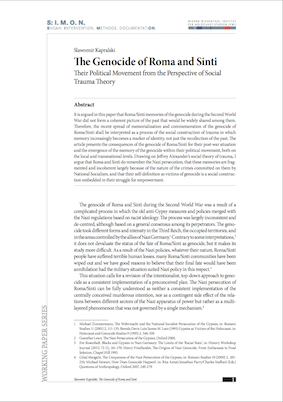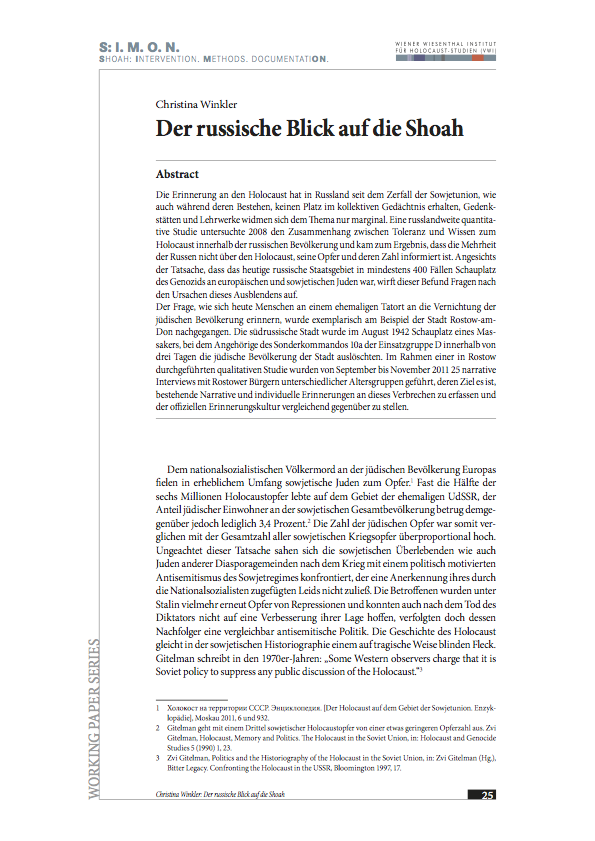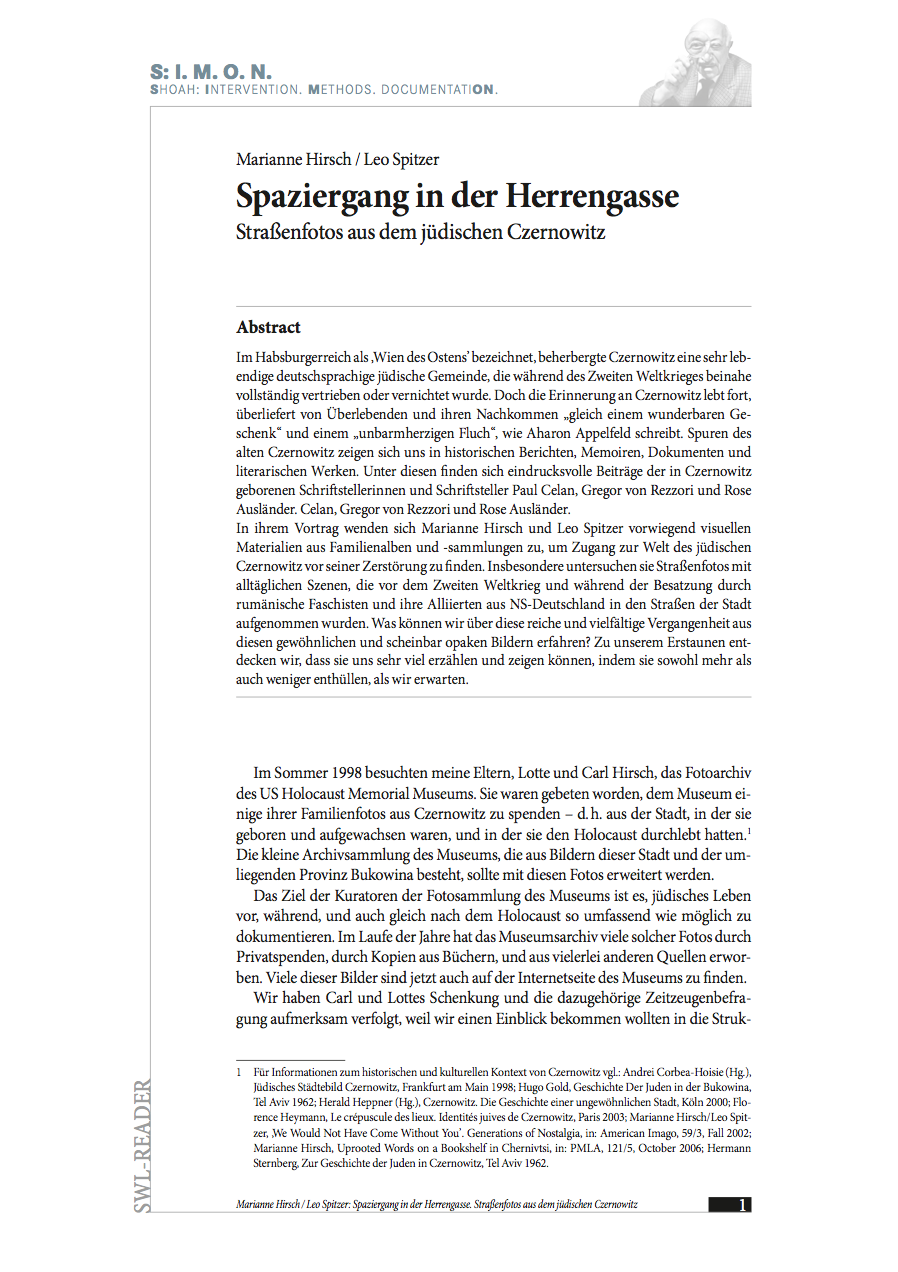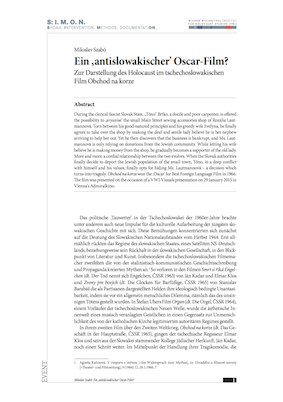 It is argued in this paper that Roma and Sinti memories of the genocide during the Second World War did not form a coherent picture of the past that would be widely shared among them. Therefore, the recent spread of memorialization and commemoration of the genocide of Roma and Sinti shall be interpreted as a process of the social construction of trauma in which memory increasingly becomes a marker of identity, not just the recollection of the past. The article presents the consequences of the genocide of Roma and Sinti for their post-war situation and the emergence of the memory of the genocide within their political movement, both on the local and transnational levels. Drawing on Jeffrey Alexander’s social theory of trauma, I argue that Roma and Sinti do remember the Nazi persecution, that these memories are fragmented and incoherent largely because of the nature of the crimes committed on them by National Socialism, and that their self-definition as victims of genocide is a social construction embedded in their struggle for empowerment.
It is argued in this paper that Roma and Sinti memories of the genocide during the Second World War did not form a coherent picture of the past that would be widely shared among them. Therefore, the recent spread of memorialization and commemoration of the genocide of Roma and Sinti shall be interpreted as a process of the social construction of trauma in which memory increasingly becomes a marker of identity, not just the recollection of the past. The article presents the consequences of the genocide of Roma and Sinti for their post-war situation and the emergence of the memory of the genocide within their political movement, both on the local and transnational levels. Drawing on Jeffrey Alexander’s social theory of trauma, I argue that Roma and Sinti do remember the Nazi persecution, that these memories are fragmented and incoherent largely because of the nature of the crimes committed on them by National Socialism, and that their self-definition as victims of genocide is a social construction embedded in their struggle for empowerment.
Editorial
 S:I.M.O.N. is an e-journal of the Vienna Wiesenthal Institute for Holocaust Studies (VWI). It appears twice a year in English and German language. S:I.M.O.N. aims at both a transnational and comparative history of the Holocaust and Jewish Studies in Central and Eastern Europe within the broader contexts of the European history of the 20th and 21st century, including its prehistory, consequences and legacies as well as the history of memory.
S:I.M.O.N. is an e-journal of the Vienna Wiesenthal Institute for Holocaust Studies (VWI). It appears twice a year in English and German language. S:I.M.O.N. aims at both a transnational and comparative history of the Holocaust and Jewish Studies in Central and Eastern Europe within the broader contexts of the European history of the 20th and 21st century, including its prehistory, consequences and legacies as well as the history of memory.
S:I.M.O.N. serves as a forum for discussion of various methodological approaches. The journal especially wishes to strengthen the exchange between researchers from different scientific communities and to integrate both the Jewish history and the history of the Holocaust into the different “national” narratives. It also lays a special emphasis on memory studies and the analysis of politics of memory. S:I.M.O.N. uses a double-blind review system, which means that both the reviewer’s and the author’s identities are concealed from each other hroughout the review process.
Shoah: The journal deals with the history of the Shoah from multidisciplinary, transnational and comparative perspectives. It seeks to integrate studies on Jews as well as on other groups of victims of the Holocaust, especially on Roma, and of so far less researched regions of (East) Central and (South) Eastern Europe.
Intervention. The journal reports on research projects and their transmission into public events. It also informs about current educational and remembrance programs.
Methods. The journal serves as a forum for the discussion of methodological approaches as, for instance, the everyday history, oral history, gender history, the history of violence, anti-Semitism and racism and the theory of memory and memory politics.
DocumentatiON. The journal contributes to critical approaches on using and interpreting archival materials in the 21st century.
Download the current issue S:I.M.O.N. 2017/2.
Articles
Christina Winkler
Der russische Blick auf die Shoah
 Both during the Soviet era and after its collapse, there has been no room for Holocaust remembrance in Russia's collective memory; memorials and textbooks only marginally touch on the topic. In 2008, quantitative research across Russia investigated the relationship between tolerance and Holocaust knowledge within the Russian population and concluded that the majority of Russians were not aware of the Holocaust, its victims and their numbers. Considering the fact that the current territory of Russia includes at least 400 sites of perpetration of the genocide of European and Soviet Jews, these results urge the question of the causes for this suppression.
Both during the Soviet era and after its collapse, there has been no room for Holocaust remembrance in Russia's collective memory; memorials and textbooks only marginally touch on the topic. In 2008, quantitative research across Russia investigated the relationship between tolerance and Holocaust knowledge within the Russian population and concluded that the majority of Russians were not aware of the Holocaust, its victims and their numbers. Considering the fact that the current territory of Russia includes at least 400 sites of perpetration of the genocide of European and Soviet Jews, these results urge the question of the causes for this suppression.
The city of Rostov-on-Don served as an example in order to address the question of how people now remember the former site of the extermination of the Jewish population. This southern Russian city became the site of a massacre in August 1942, when members of the special commando 10a, part of Einsatzgruppe D annihilated the Jewish population of the city within three days. In the context of qualitative research undertaken in Rostov, 25 narrative interviews were conducted with citizens of Rostov from a range of age groups between September and November 2011. It was the aim of the interviews to record the existing narrative and individual memories of this crime and to compare and contrast these with the official culture of remembrance.
SWL-Reader
Marianne Hirsch/Leo Spitzer
Spaziergang in der Herrengasse. Straßenfotos aus dem jüdischen Czernowitz
 Czernowitz was the Habsburg Empire's „Vienna of the East“; it had a lively German-speaking Jewish community, almost all of whom were persecuted or murdered during the time of the Second World War. Yet the memory of Cernowitz lives on, passed on as it is by survivors and their descendants “like a wonderful present“ and a „relentless curse“, as noted by Aharon Appelfeld. We find evidence of old Cernowitz in historical reports, memoirs, documents and literary works. These include impressive contributions by Cernowitz-born writers.
Czernowitz was the Habsburg Empire's „Vienna of the East“; it had a lively German-speaking Jewish community, almost all of whom were persecuted or murdered during the time of the Second World War. Yet the memory of Cernowitz lives on, passed on as it is by survivors and their descendants “like a wonderful present“ and a „relentless curse“, as noted by Aharon Appelfeld. We find evidence of old Cernowitz in historical reports, memoirs, documents and literary works. These include impressive contributions by Cernowitz-born writers.
In their lecture, Marianne Hirsch and Leo Spitzer focussed primarily on materials from family albums and collections in order to tap into the world of Jewish Cernowitz before its destruction. In particular, they analysed street photographs depicting daily life which had been taken on the city's streets before the Second World War and during the occupation by Romanian fascists and their allies from Nazi Germany. What do these ordinary and apparently opaque images tell us about the rich and diverse past? We were astonished to discover that they tell and show us a lot in that they reveal both more and less than we had expected.
Events
Miloslav Szabó
Ein ‚antislowakischer' Oscar-Film? Zur Darstellung des Holocaust im tschechoslowakischen Film Obchod na korze
 During the clerical-fascist Slovak State, "Tóno" Brtko, a docile and poor carpenter, is offered the possibility to 'aryanise' the small Main Street sewing accessories shop of Rozália Lautmannová. Torn between his good-natured principles and his greedy wife Evelyna, he finally agrees to take over the shop by making the deaf and senile lady believe he is her nephew arriving to help her out. Yet he then discovers that the business is bankrupt, and Ms. Lautmannová is only relying on donations from the Jewish community. While letting his wife believe he is making money from the shop, he gradually becomes a supporter of the old lady. More and more, a cordial relationship between the two evolves. When the Slovak authorities finally decide to deport the Jewish population of the small town, Tóno, in a deep conflict with himself and his values, finally opts for hiding Ms. Lautmannová – a decision which turns into tragedy. Obchod na korze won the 'Oscar' for Best Foreign Language Film in 1966. The film was presented on the occasion of a VWI-Visuals presentation on 29 January 2015 in Vienna's Admiralkino.
During the clerical-fascist Slovak State, "Tóno" Brtko, a docile and poor carpenter, is offered the possibility to 'aryanise' the small Main Street sewing accessories shop of Rozália Lautmannová. Torn between his good-natured principles and his greedy wife Evelyna, he finally agrees to take over the shop by making the deaf and senile lady believe he is her nephew arriving to help her out. Yet he then discovers that the business is bankrupt, and Ms. Lautmannová is only relying on donations from the Jewish community. While letting his wife believe he is making money from the shop, he gradually becomes a supporter of the old lady. More and more, a cordial relationship between the two evolves. When the Slovak authorities finally decide to deport the Jewish population of the small town, Tóno, in a deep conflict with himself and his values, finally opts for hiding Ms. Lautmannová – a decision which turns into tragedy. Obchod na korze won the 'Oscar' for Best Foreign Language Film in 1966. The film was presented on the occasion of a VWI-Visuals presentation on 29 January 2015 in Vienna's Admiralkino.
Sławomir Kapralski: The Genocide of Roma and Sinti and Their Political Movement from the Perspective of Social Trauma Theory
„... zu lesen, wenn alles vorüber ist“
Rita Maria Rockenbauer, Briefe 1938 –1942
Wien 2014
Partituren der Erinnerung.
Der Holocaust in der Musik
Scores of Commemoration.
The Holocaust in Music
Wien 2015
Before the Holocaust Had Its Name. Early Confrontations of the Nazi Mass Murder of the Jews
Wien 2016
Akademisches Milieu, Juden und Antisemitismus an den Universitäten Europas zwischen 1918 und 1939
Academic Milieu, Jews and Antisemitism at European Universities between 1918 and 1939
Wien 2016






